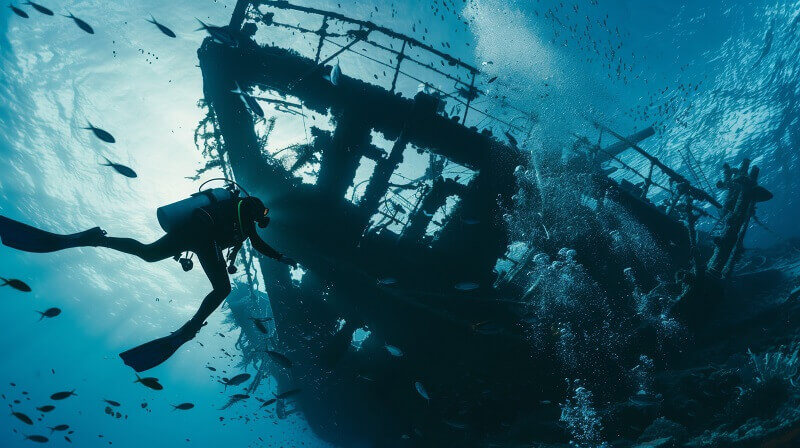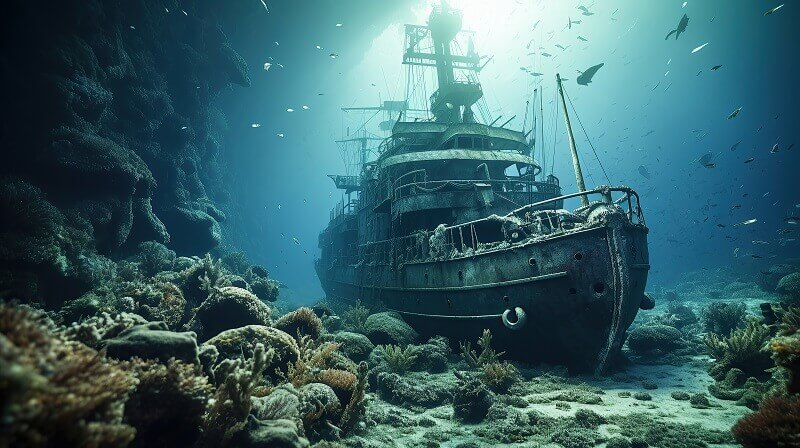The sinking of the RMS Titanic on its maiden voyage in 1912 is one of the most notorious maritime disasters in history. Over 1,500 lives were lost when the “unsinkable” ship struck an iceberg and sank in the frigid North Atlantic. While the tragedy itself has captivated people for decades, the wreck’s resting place at an astounding depth below the ocean surface adds to its allure and intrigue.
This article will explore the incredible 12,500 foot depth where the Titanic’s distorted remains lie, exploring the various challenges of reaching such abyssal depths, the immense pressures and dark environments involved, and why this iconic shipwreck site has spurred generations of explorers to pursue it despite the dangers. We’ll uncover the mysteries of the Titanic’s unfathomable underwater grave.
Where Did the Titanic Sink?
The Titanic was famously believed to be unsinkable, making its sinking a shocking event. On that fateful night, the ship was navigating dangerous waters about 400 miles south of Newfoundland, Canada. Despite their vigilance, the lookouts spotted an iceberg too late to change course. The collision with the iceberg ripped open the ship’s hull, allowing water to flood in. This breach caused the massive 882-foot vessel to break apart and eventually sink more than two miles to the seafloor below.
How Deep Is the Titanic Wreckage?
So just how far down did the Titanic fall to its grave? The wreck site rests at an astounding 12,500 feet (2.4 miles or 3,810 meters) straight down – nearly as tall as 10 Empire State Buildings stacked on top of each other. To provide context, the average depth of the entire global ocean is only around 12,100 feet. The wreck of this famous ship came to rest at the very edge of the deep abyssal plain.
The Titanic’s Resting Place
At a depth of 2.4 miles, the wreck lies scattered in two main pieces across a debris field spanning around 15 square miles. The bow (front) section is the most intact part, having plunged at a steep angle and dug into the silt after breaking off from the stern while sinking. Meanwhile, the stern (rear portion) was left severely mangled and smashed nearly flat after enduring immense pressure on the way down.

Once on the ocean floor, metal-eating bacteria and salt corrosion began eating away at the wreck structure. This deterioration has steadily continued for the past century. Some experts estimate the entire wreckage could fully dissolve away within the next few decades if this decay remains unchecked.
The Depth of the Ocean
To truly understand the immense depth the Titanic now resides at, it helps to know about the layered zones of the ocean. The uppermost area extending a few hundred feet down is the euphotic or “sunlight” zone where most marine life lives and photosynthesis occurs.
Beneath this sunlit region lies the dysphotic “twilight” zone which receives very faint, scattered rays of sunlight. But the majority of the Titanic wreckage rests far below even this dim realm, deep within the aphotic or “midnight” zone between around 3,300 – 13,100 feet where there is perpetual blackness as zero sunlight can penetrate.
And below this lightless layer is the hadal “trench” zone, containing the deepest oceanic trenches on Earth like the famous Mariana Trench which plunges over 35,000 feet (nearly 7 miles) down at its deepest point.
Exploring the Titanic’s Depth
Uncovering the mysteries of the Titanic wreck meant overcoming huge barriers like crushing pressure, total darkness, jagged terrain, and strong currents at these abyssal depths. Locating and exploring the wreck in the mid-1980s via manned submersibles like Alvin by teams led by Robert Ballard was an immense achievement pursued at great risk.
It took over 70 years after the sinking for the rotted wreck and debris field to finally be discovered in 1985. This was accomplished using newly developed unmanned robotic sleds with cameras scouring the seafloor. Since then, only a handful of explorers have actually seen the remains in person due to the extreme depths involved.
Pressure at the Titanic’s Depth
The tremendous pressure at 12,500 feet down is an almost inconceivable 6,500 pounds per square inch. This intense force is nearly equivalent to the entire weight of a massive Boeing 747 jetliner pressing down on every square foot of area. It’s over 450 times greater than the pressure we feel at sea level.
Such immense hydraulic force would instantly crush a human like a soda can. That’s why specially reinforced deep-sea submersibles with incredibly thick hulls are required to withstand these titanic pressures. Very few vessels have ever been built sturdy enough to transport people safely to these depths and back.
The deepest any human has traveled is around 35,853 feet down into the Challenger Deep in the Mariana Trench, accomplished during expeditions in the 1960s and more recently in 2019. Yet even this record-setting depth is still nearly a mile shallower than where the Titanic rests. Remarkably, scientists have discovered tiny single-celled organisms called extremophiles that can survive the crushing pressures at the very bottoms of these hadal trenches.
Conclusion
For over 100 years, the ghostly remains of the Titanic have been preserved in the frigid, pitch-black, hyper-pressurized environment of the deep Atlantic abyss. This wreck site is both an eerie underwater tomb and stark reminder of humanity’s vulnerabilities against the raw power of nature. Despite the dangers, our drive to reveal this legendary shipwreck’s tragic tale and glimpse its wreckage has pushed generations of explorers to innovate and venture into the deepest realms of the ocean.
While further decay from bacteria and currents is inevitable until the wreck eventually dissolves away, this iconic site has cemented its legacy as a poignant memorial to that fateful night in 1912. It also endures as a symbolic reminder of our boundless curiosity and will to discover and understand even the most extreme environments on our planet.



